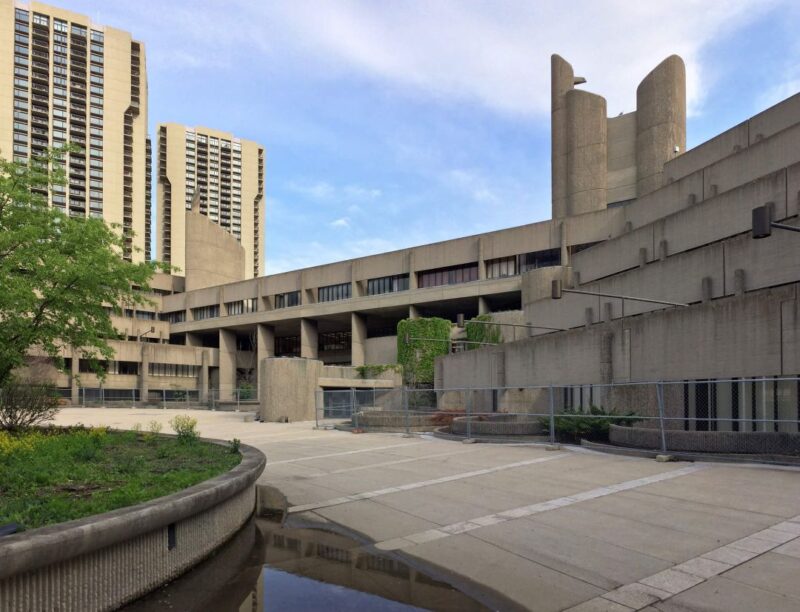The next time you are visiting West End in Boston, drop by 19 and 25 Staniford Street to pay a visit to the marvel of Brutalism that is the Boston Government Service Center, formally the Joseph A. Langone, Jr. Memorial Center. This center consists of a pair of structures: the Charles F. Hurley Building and the Erich Lindemann Building, along with their courtyard.
When you first behold this structure with its bush-hammered concrete, its lofty columns, and its almost sculptural projections, it will no doubt capture your imagination. But as unusual as the building appears at a glance, you would not guess at just how startling—and at times, harrowing—its history is.
Paul Rudolph’s Theatrical Vision in Concrete

The Boston Government Service Center was constructed to serve as the city’s offices for unemployment assistance and mental health. The Lindemann Building houses the Erich Lindemann Mental Health Center.

Paul Rudolph, the coordinator for the project to build the Boston Government Service Center, was a harsh critic of the International Style, which was popular at the time. He believed that the style was impersonal, blandly utilitarian, and did not account for the “psychology of space.” He wanted to provide “space for the subconscious” in his service center.
To that end, he created an imposing, theatrical space in keeping with the philosophy of the Great Society. At the same time, he incorporated smaller, enclosed spaces and curved, organic surfaces. His goal was to communicate to those who entered the service center that big government was looking out for their interests—and that each of them mattered as individuals. As Harvard Design Magazine quotes Dr. Frank Paolitto as explaining, “the building discourages the idea that people are not worthwhile.”
Space for the Subconscious … or for Madness?
Alas, while it seems that Rudolph’s aims were noble, there is a great deal of contention over whether he actually achieved them. Moreover, many suggest that the building may have done the opposite of supporting mental health.
Some descriptions of the Boston Government Service Center are almost phantasmagorical. Philip Nobel writes in his article, “The Architecture of Madness” that “the spaces inside reflect Rudolph’s romanticized view of mental illness: eerie, twisting stairways, one of which leads nowhere like an oubliette in a Medieval keep; amorphous passages that never reveal their ends; a chapel that creates a stirring, dismal ambiance through spatial theatrics.”
Consider as another example the “frog’s head” subtly suggested by this architectural motif on the exterior.

It looks like a frog—but the effect is so subtle that one might think one were imagining it. If a patient were already struggling to make sense of reality, one can imagine that the sense that a frog might or might not be watching one from the building’s façade could be deeply unnerving rather than whimsical and delightful.
Various features of the architecture of the Boston Government Service Center were considered to be so disorienting that some people have even blamed them for patient deaths.
The most dramatic example is the altar made of concrete located inside the chapel. A patient self-immolated there. Philip Nobel quotes a psychiatrist who used to work there as saying, “It looks like a place that should be used for human sacrifice.” In short, he thought the very design of the space encouraged suicide by such a means.
The Hurley Building Hangs in the Balance

The Massachusetts Division of Capital Asset Management and Maintenance (DCAMM) announced in 2019 that they would be working to redevelop the Boston Government Service Center. DCAMM has considered outright demolishing the Hurley Building. For the time being, the protests of organizations like Docomomo and the Paul Rudolph Heritage Foundation appear to have spared it from being completely destroyed. But there are still concerns.
The Architect’s Newsletter suggests that DCAMM still wants to replace the building entirely. Docomomo says that “total demolition” does not appear to be on the table right now. But Docomomo does point out that the two new towers proposed would not really mesh well with the existing structure.
So, the Boston Government Service Center does still need our help. Whether you think it was an ambitious structure that honors the value of every person or an unsettling nightmare, there is no denying its architectural significance. Be sure to let DCAMM know your feelings if you support preserving the Hurley Building.
Learn more about Brutalist architecture, and check out another example of Brutalist design in a government structure in the Robert C. Weaver Federal Building. Follow us on Instagram, Facebook and Pinterest for more Atomic Ranch articles and ideas!












